In this article, you will discover how to develop a trading strategy, establish a system, and maintain a transaction journal. Once you have learned how to develop a trading plan and identified your trading style, it is time to create your own personalized Forex trading system!
Building a Forex Trading System

A Forex trading system serves as a reliable signal generator for traders. It is a system primarily based on technical analysis, and strict adherence to its rules is paramount. Theoretically, this system eliminates biases and emotions from trading decisions, as traders simply follow the predefined rules of the Forex trading system, regardless of prevailing market conditions.
If you conduct a Google search for Forex trading systems, you will come across numerous claims of possessing the “Holy Grail” – a miraculous system that guarantees 100% success rate and can be obtained for just a few thousand dollars. These Forex trading systems are purported to generate thousands of pips every week, with no possibility of losses.
Such claims may entice you and convince you to open your wallet, as they showcase impressive results achieved by these seemingly flawless systems. You might be tempted to believe that by acquiring a system capable of generating thousands of pips weekly, you can swiftly recoup your investment.
However, it is crucial to exercise caution and refrain from rushing into decisions. Take the time to carefully evaluate the situation before divulging your bank account details. While it is true that many trading systems can yield highly effective results with a high success rate, the key challenge lies in traders’ lack of discipline and their tendency to deviate from the system’s rules.
The second truth is that instead of spending thousands of USD on a pre-built system, you can actually invest time in developing your own trading system for free. The third truth is that creating trading systems is not overly complex. The challenge lies in adhering to the rules you establish within the system.
While there are numerous articles promoting system purchases, we have yet to come across any that provide guidance on building your own system. This tutorial will walk you through the necessary steps to develop a suitable Forex trading system.
Goals of a Forex Trading System
We anticipate you might say that the goal of a Forex trading system is to earn one billion USD! Although that is an admirable goal, it is not the type of goal that will make you a successful forex trader. When developing a Forex trading system, you need to accomplish two crucial goals:
- Your system should be able to identify trends as early as possible.
- Your system should be able to shield you from market pitfalls.
If you can achieve these two goals with your Forex trading system, you significantly enhance your chances of success. The challenge lies in striking a balance between these goals. If you have a system primarily focused on capturing trends early, it may expose you to false breakouts.
Conversely, if you have a Forex trading system centered on avoiding false breakouts, you will miss out on numerous opportunities. Your objective, when developing a trading system, is to find the optimal equilibrium between these two goals.
Efficiently identifying trends while also aiding in the differentiation between false and genuine signals. Countless forex traders share ideas about entirely free trading systems, allowing you to discover one or two valuable concepts for constructing your Forex trading system.
Designing a Forex Trading System in 6 Steps
The primary focus of this lesson is to provide guidance on designing a Forex trading system. While creating a system doesn’t require much time, thorough testing is essential and can take a significant amount of time. Therefore, patience is key as a good Forex trading system has the potential to generate substantial profits in the long run.
Step 1: Timeframe
The first step is to determine your trading style. Are you a day trader or a swing trader? Do you prefer analyzing daily, weekly, monthly, or even yearly charts? How long do you intend to hold your trades?
These factors will help you identify the most suitable timeframe for your trading activities. While considering multiple timeframes is important, you will primarily focus on one timeframe when searching for trading signals.
Step 2: Identify Trend-Confirmation Indicators
To identify trends as early as possible, it is advisable to use indicators that can achieve this objective. The Moving Average (MA) is one of the most popular indicators used by traders to determine trends.
By utilizing two moving averages (a fast one and a slow one), traders wait for a crossover where the fast line intersects the slow line. This forms the foundation of the moving average crossover strategy.
In its simplest form, the crossover of moving averages provides a quick way to identify new trends. Of course, there are alternative methods, but moving averages are among the easiest indicators to work with.
Step 3: Confirm Trends with Additional Indicators
The second goal is to avoid false signals. To achieve this, it is important to confirm potential trends using additional indicators when a signal for a new trend is identified. There are numerous reliable technical indicators available for confirming trends, such as MACD, Stochastic, and RSI.
As you become more familiar with various indicators, you will discover your preferred ones that can be integrated into your Forex trading system.
Step 4: Determine Risk
When developing a Forex trading system, it is crucial to establish the amount of capital you are willing to risk on each trade. While discussing losses may not be favorable, successful traders prioritize risk management BEFORE focusing on potential profits.
The acceptable level of risk varies from person to person. You must decide how much capital is sufficient to maintain trading psychology stability while also avoiding excessive risk on a single trade. Further lessons will delve into capital management, which plays a significant role in determining the appropriate risk level for each trade.
Step 5: Determine Entry and Exit Points
Once you have identified the amount of money you are willing to risk for a trade, the next step is to find the entry and exit points that will maximize your profits.
– Entry Point
Some traders prefer to enter a trade as soon as all the indicators align and provide a good signal, even if the candle has not yet closed. Others choose to wait until the candle closes. Many professional traders believe it is best to wait until the candle closes before entering. The candle’s closure provides a more accurate confirmation of the price, compared to taking a risky entry before the candle closes. However, this is ultimately a matter of trading style.
For example, in the chart below, this trader enters the trade when the candle closes below the support line.
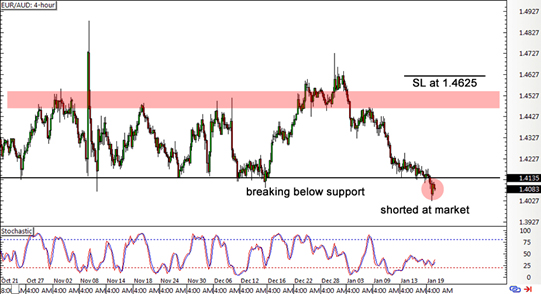
– Exit Point
There are different options for determining the exit point. One approach is to continuously adjust the stop-loss level, which means that if the price moves in your favor by a certain amount ‘X’, you move the stop-loss level by ‘X’. Another approach is to set a target from the beginning and exit the trade when the price reaches the stop-loss level.
For instance, some traders choose to set the stop-loss level at specific support and resistance levels. In the chart below, the exit point is set at a specific price level near the end of the downward price channel.
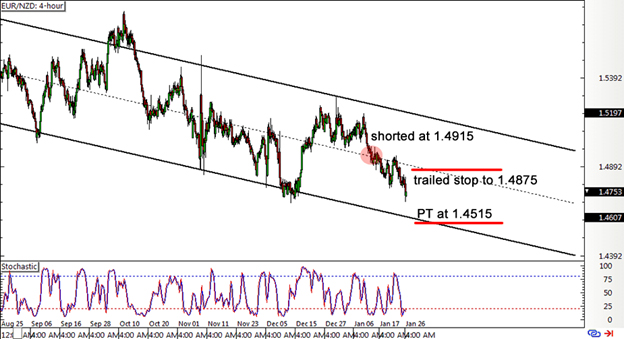
Some traders simply choose an exit range (measured from the entry point) equal to the stop-loss range (fixed risk) for each trade. However, regardless of the stop-loss approach you decide to use, discipline is key. Never prematurely cut a trade, regardless of what happens. Stick to your Forex trading system! Ultimately, you have developed it!
Another approach is to establish criteria that, when met, will signal you to exit the trade. For example, if the indicators reverse to a certain level, then you will exit the trade.
Step 6: Write down the Rules and Stick to Them!
This is the most important step in creating a Forex trading system. You MUST write down the rules and ALWAYS adhere to them. Discipline is essential and must be strictly followed. No system will be effective if you do not follow the rules, so remember to maintain discipline.
How to Test the Quality of Your Forex Trading System

The quickest way is to find charting software packages that allow you to rewind time and conduct testing. By moving the chart back to the past, you can apply the system rules and replay trades.
Keep detailed records of your trades and be honest with yourself! Record wins, losses, average wins, and average losses. If you are satisfied with the results, you can move on to the next phase and trade directly on a demo account.
Trade the new system directly on a demo account for at least two months. This will give you a sense of trading with the Forex trading system in a moving market. Trust us, live trading is very different from reviewing the past.
After two months of trading directly on a demo account, you will be able to assess whether the system is truly effective. If you achieve good results, then you can trade the system directly on a REAL account. At this point, you should feel confident in your Forex trading system and execute trades comfortably without hesitation.
Building a Forex Trading System in 3 Steps
Having learned the fundamental aspects of technical analysis, it’s time to combine all this knowledge and construct a simple Forex trading system. This system revolves around the crossover of two moving averages, utilizing them to determine whether to buy or sell.
Supplementary technical indicators are also employed to validate trades before entering them. You will acquire the skills to utilize various technical indicators for establishing explicit entry and exit points. The construction of a Forex trading system can be achieved through the following three straightforward steps:
Timeframe identification:
Trade on the daily chart, known as swing trading.
Apply a 5-period Simple Moving Average (SMA) to the closing price.
Apply a 10-period SMA to the closing price.
Utilize Stochastic (14,3,3) and RSI (9) indicators.
Entry point determination:
Initiate a BUY trade when the 5-period SMA crosses above the 10-period SMA, and both Stochastic lines are ascending (avoid entering if Stochastic is already in the overbought region), and RSI exceeds 50.
Initiate a SELL trade when the 5-period SMA crosses below the 10-period SMA, and both Stochastic lines are descending (avoid entering if Stochastic is already in the oversold region), and RSI is below 50.
Exit point determination:
Exit the trade when the 5-period SMA reverses its crossover with the 10-period SMA in the opposite direction of the trade, OR when RSI returns to the 50 level.
Exit the trade if it reaches the predetermined stop-loss level of 2% of the trading account.
If the daily chart seems too slow, you can experiment with alternative time frames. However, remember that smaller time frames are more prone to inaccurate trading signals. Even if the trades meet all the specified rules, they might still result in stop losses.
Always bear in mind that a Forex trading system is only effective when diligently adhered to. Discipline is crucial in following the established rules.
Determining the Optimal Time Frame for Trading
Which time frame should you trade with your Forex trading system? The smaller the time frame, the more challenging it becomes to develop a successful system. In other words, devising a Forex trading system on a 5-minute chart is more difficult than creating one based on the daily chart.
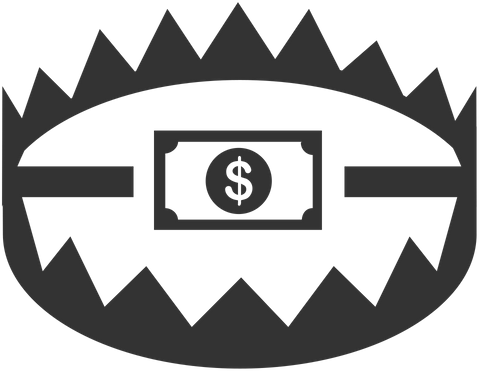
Smaller time frames introduce more noise into the analysis. In summary, smaller time frames typically yield lower profits and involve lower risk per trade. Therefore, it is essential to strike a balance between the trading account size and the level of risk you are willing to undertake.
The Trap for New Traders
Let’s examine what is known as “The Trap for New Traders.”
The smaller your trading account, the smaller the timeframe you should trade in. Trading on smaller timeframes can be more challenging. Novice traders often enter the trading world with limited capital, hoping to make quick profits. As a result, they opt to trade on short timeframes, believing that day trading is an easy path to earning money.
They begin trading on 1-minute or 5-minute charts, aiming to capture a few pips in the market. However, by doing so, they inadvertently place themselves in a difficult situation because they are trading within an uncomfortable timeframe due to their lack of experience. In a short period, they experience rapid failures.
Developing Forex trading systems on daily timeframes is much easier compared to 5-minute charts. Therefore, we advise new traders to construct Forex trading systems based on daily charts. It is crucial to build confidence and skills in system development rather than pursuing immediate profits. Take a slow but steady approach.
Learn more: Writing a Forex Journal – Important Trading Habits
Is Scalping Suitable?
Scalping consistently entices traders. With scalping, it is common to trade on small timeframes, such as 5 minutes or less. The primary idea is to enter a position and capture a few pips of profit with a large trading volume.
The appeal lies in the fact that within such short timeframes, the risk is minimized, allowing traders to operate with smaller accounts. Market waves occur more frequently, resulting in an increased number of winning trades.
The combination of high trade frequency and the win rate of a Forex trading system can yield significant profits. However, scalping is challenging to execute for most traders. The majority of those who attempt scalping ultimately fail.
If you are new to trading, we do not recommend scalping. Why? Simply because you would be competing against high-frequency trading strategies employed by bots programmed by large financial institutions. It is akin to a novice basketball player trying to compete against LeBron James.

Another substantial hurdle is the trading costs associated with spreads and slippage. The trading cost for an average trade is typically half of the spread. For instance, if you pay a 2-pip spread to enter and exit a trade and earn a profit of 4 pips, half (50%) of your profit will be absorbed by the spread!
Scalping entails lower profits per trade as you delve into smaller timeframes, while your costs remain fixed. If you trade on a longer timeframe like the daily chart and earn 400 pips, you would pay 0.5% of your profit in fees, compared to the 50% in the previous example. That represents a significant difference!
As the negative impact of spreads and slippage increases, they constitute a more substantial portion of your profits. A one-pip slippage is negligible when holding a long-term trade with an average profit of $100 per trade. However, in a scalping system, one pip can make the difference between success and failure. Additionally, latency issues, computer glitches, internet problems, and your error rate need to be factored in.
Once again, on larger timeframes, you have the option to exit trades immediately or within seconds, and it won’t have much significance. However, in scalping, entering and exiting trades is equivalent to a regular loss.
To sum up, if you are in the process of building a Forex trading system or if you don’t have a suitable trading strategy yet, it’s advisable to focus on developing a system on higher timeframes first.
Setting up a Forex trading system is not as challenging as you may think. As you can observe, we now have all the components required to construct an optimized Forex trading system. Firstly, we have determined that this is a swing trading system, and we will be trading on the daily chart (DAILY).
Next, we employ moving averages (MA) to help identify new trends as early as possible. Stochastic assists in enhancing the reliability of the intersection of the two moving averages, while also aiding in avoiding overbought and oversold regions. RSI serves as an additional tool to confirm the strength of the trend.
It is crucial to define the risk for each trade. For this Forex trading system, we are prepared to risk 100 pips per trade. Typically, the higher the timeframe, the more willing you are to accept higher risks because profitability goes hand in hand with risk. Subsequently, we establish clear entry and exit rules.
Example: Buying EURUSD
Here is an illustration of a buy order.
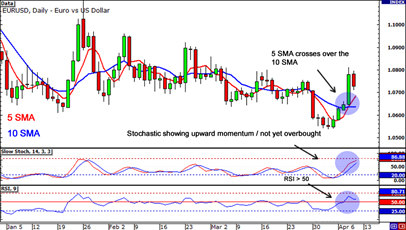
According to the rules of the Forex trading system, this would be an opportune time to buy. You record the entry price, stop-loss level, and exit strategy in your trading journal.
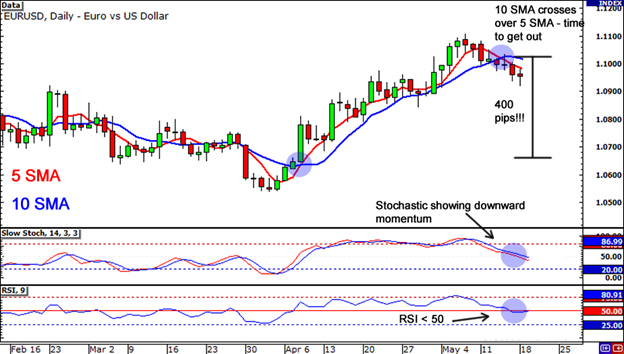
In this instance, you have gained some pips! You can observe that when the moving averages intersect in the opposite direction, it signifies a favorable time to exit the trade.
Example: Selling EURUSD
Below is an example of a sell order.
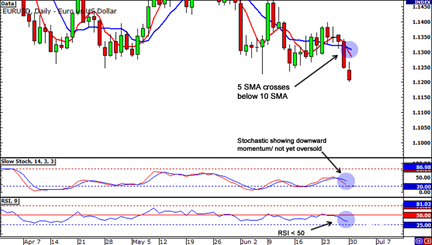
The intersection of the moving averages, along with the Stochastic showing a downward momentum, not being in the oversold zone, and the RSI below 50, indicates an appropriate time to enter a sell order. You record the entry price, stop-loss level, and exit strategy in your trading journal.
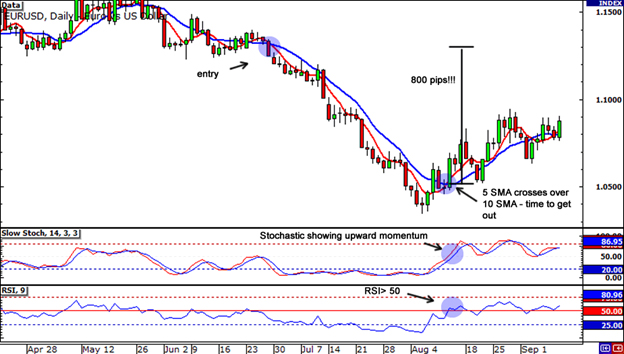
Effective Forex Trading System
This trend is considerably robust, and the currency pair has declined by nearly 800 pips before the two moving averages intersect in the opposite direction. Always remember the adage “Keep It Simple.” Essentially, Forex trading systems do not need to be overly complex.
There’s no requirement to have a multitude of indicators on the chart. In fact, maintaining simplicity will help alleviate headaches. The most critical aspect is discipline. We consistently emphasize the utmost importance of discipline. YOU MUST ALWAYS ADHERE TO THE RULES OF THE TRADING SYSTEM!
If you have thoroughly backtested the Forex trading system using historical data and the system has also performed well on a demo account for at least one or two months, then it is time to commence trading on a live account. Afterward, you should feel confident in adhering to the rules, and ultimately, you will generate profits. Trusting the Forex trading system is equivalent to trusting yourself!
Summary of Building a Forex Trading System
While there are numerous effective trading systems, many forex traders fail due to a lack of discipline, resulting in account losses.
A Forex trading system should strive to accomplish two main objectives:
- Identifying trends as early as possible.
- Avoiding market sweeps or sudden reversals.
It is advisable to directly utilize a Forex trading system on a demo account for a minimum of 2 months. Once you have traded on the demo account for at least 2 months and achieved profitable results, you can proceed to trade on a live account.
Here are 6 steps to develop a Forex trading system:
- Determine the time frame.
- Identify indicators to promptly detect trends.
- Employ indicators to avoid market sweeps and confirm trend directions.
- Assess the risk involved.
- Define entry and exit points for trades.
- Establish clear rules for the trading system and strictly adhere to them!

There are 3 stages for testing a Forex trading system:
- Stage 1: Conduct backtesting by utilizing historical data to test the system’s signals. Trade according to the system’s rules and record the trading outcomes.
- Stage 2: If Stage 1 proves successful, trade the Forex trading system directly on a demo account for at least 2 months.
- Stage 3: Once you have traded your Forex trading system on a demo account for a minimum of 2 months and achieved consistent profitability, you are ready to engage in real-money trading.
However, always remember to consistently abide by the established rules!
